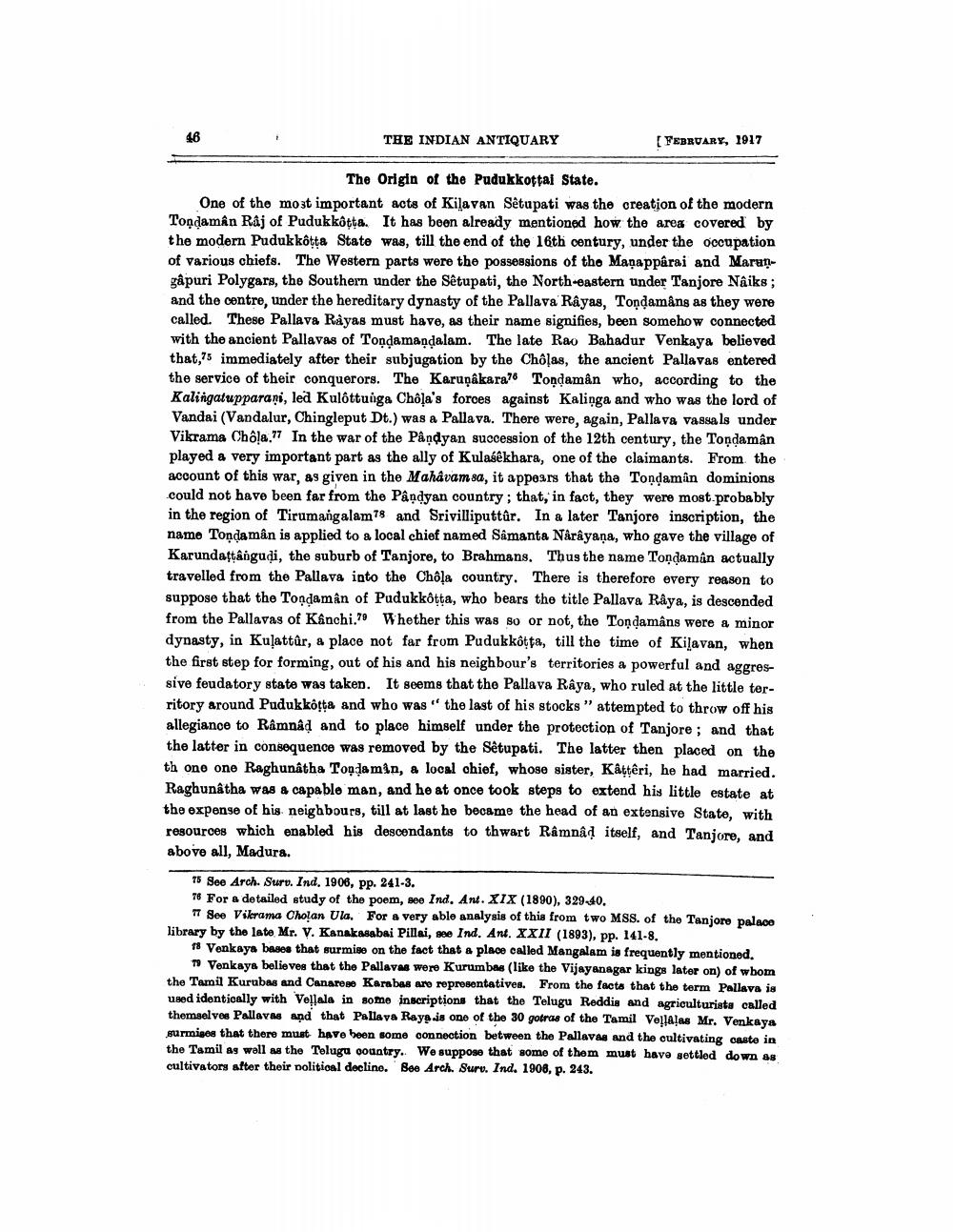________________
THE INDIAN ANTIQUARY
(FEBRUARY, 1917
The Origin of the Pudukkottai State. One of the most important acts of Kila van Setupati was the creation of the modern Tondamên Râj of Pudukkôtta. It has been already mentioned how the area covered by the modern Pudukkotta State was, till the end of the 16th century, under the occupation of various chiefs. The Western parts were the possessions of tho Maņappârai and Marungâpuri Polygars, the Southern under the Setupati, the North-eastern under Tanjore Nâiks ; and the centre, under the hereditary dynasty of the Pallava Rayas, Tondamång as they were called. These Pallava Rayas must have, as their name signifies, been somehow connected with the ancient Pallavas of Tondamandalam. The late Rao Bahadur Venkaya believed that,75 immediately after their subjugation by the Cholas, the ancient Pallavas entered the service of their conquerors. The Karuņâkara76 Toņdamên who, according to the Kalingatupparani, led Kulottuuga Chôļa's forces against Kalinga and who was the lord of Vandai (Vandalur, Chingleput Dt.) was a Pallava. There were, again, Pallava vassa ls under Vikrama Chôla.In the war of the Påndyan succession of the 12th century, the Tondaman played a very important part as the ally of Kulasekhara, one of the claimants. From the account of this war, as given in the Mahavam sa, it appears that the Tondaman dominions could not have been far from the Pandyan country; that, in fact, they were most probably in the region of Tirumangalam78 and Srivilliputtûr. In a later Tanjore inscription, the name Tondamân is applied to a local chief named Samanta Narayana, who gave the village of Karundaţtângudi, the suburb of Tanjore, to Brahmans. Thus the name Tondamân actually travelled from the Pallava into the Chola country. There is therefore every reason to suppose that the Tondamîn of Pudukkotta, who bears the title Pallava Raya, is descended from the Pallavas of Kanchi.79 Whether this was so or not, the Tondamâns were a minor dynasty, in Kulattar, a placo not far from Pudukkotta, till the time of Kilavan, when the first step for forming, out of his and his neighbour's territories a powerful and aggressive feudatory state was taken. It seems that the Pallava Raya, who ruled at the little territory around Pudukkotta and who was the last of his stocks" attempted to throw off his allegiance to Râmnad and to place himself under the protection of Tanjore ; and that the latter in consequence was removed by the Sêtupati. The latter then placed on the th one one Raghunatha Toqdamin, a local chief, whose sister, Káttêri, he had married. Raghunatha was & capablo man, and he at once took steps to extend his little estate at the expense of his neighbours, till at last he became the head of an extensive State, with resources which enabled his descendants to thwart Râmnâd itself, and Tanjore, and above all, Madura.
75 See Arch. Suro. Ind. 1906, pp. 241-3. 78 For a detailed study of the poem, see Ind. Ant. XIX (1890), 329.40.
TT See Vikrama Cholan Ula. For a very able analysis of this from two MSS. of the Tanjore palace library by the late Mr. V. Kanakasabai Pillai, see Ind. Ant. XXII (1893), pp. 141-8.
18 Venkaya bases that surmise on the fact that a place called Mangalam is frequently mentioned
79 Venkaya believes that the Pallaves were Kurumbas (like the Vijayanagar kings later on) of whom the Tamil Kurubas and Canarono Karabas are representatives. From the facts that the term Pallava is used identically with Vellala in some inscriptions that the Telugu Reddia and agriculturista called themselves Pallaves and that Pallava Rays is one of the 30 gotras of the Tamil VoļļAļas Mr. Venkaya gurmiges that there must have been some connection between the Pallaves and the cultivating custo in the Tamil as well as the Telugu oountry. We suppose that some of them must have settled down as cultivators after their politioal decline. Bee Arch. Suru. Ind. 1908, p. 243.




